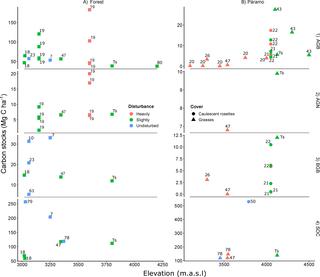PLOS ONE ( IF 2.9 ) Pub Date : 2020-03-30 , DOI: 10.1371/journal.pone.0230612 Marco Calderón-Loor 1 , Francisco Cuesta 2, 3 , Esteban Pinto 4 , William D Gosling 3

|
Few studies exist that document how high-elevation Andean ecosystems recover naturally after the cessation of human activities and this can limit the implementation of cost-effective restoration actions. We assessed Andean forest (Polylepis stands) and páramo grassland recovery along an elevation gradient (3,600–4,350 m.a.s.l.) in the Yanacocha Reserve (Ecuador) where natural recovery has been allowed since 1995. Within the Yanacocha Reserve in 2012 and 2014 the aboveground biomass (AGB), aboveground necromass (AGN) and belowground biomass (BGB) carbon (C) stocks were measured and C sequestration rates calculated as proxy of ecosystem recovery. The soil organic carbon (SOC) stock to 36-cm depth was also quantified during the 2012 survey. To explore potential drivers of spatiotemporal variation of the forest and páramo C stocks they were related to abiotic and biotic variables. Andean forest C stocks were influenced mainly by disturbance history and tree-species composition. Páramo C stocks´ spatial variation were related to the elevation gradient; we found a positive significant trend in páramo AGB-C stocks with elevation, whereas we found a significant negative trend in AGN-C stocks. Likewise, significant temporal changes were found for AGB-C and AGN-C stocks. Net increases in AGB-C stocks were the largest in the Andean forest and páramo, 2.5 Mg C ha-1 year-1 and 1.5 Mg C ha-1 year-1 respectively. Carbon sequestration rates were partly explained by environmental variables. In the Andean forest, plots with low dominance of Baccharis padifolia were observed to present higher AGB-C and lower BGB-C sequestration rates. In the páramo, higher sequestration rates for AGB-C were found at higher elevations and associated with higher levels of growth-forms diversity. Temporal changes in BGB-C stocks on the contrary were non-significant. Our results indicated that terrestrial aboveground C sequestration rates might be an appropriate indicator for assessing Andean forest and páramo recovery after human disturbance.
中文翻译:

碳固存率表明了人类在赤道安第斯山脉的干扰后生态系统的恢复。
很少有研究记录高海拔安第斯生态系统如何在人类活动停止后自然恢复,而这会限制实施具有成本效益的恢复行动。我们评估了安第斯森林(Polylepis从1995年开始允许自然恢复。在Yanacocha保护区(厄瓜多尔),沿海拔梯度(3,600–4,350 masl)恢复了帕拉莫草原。2012年和2014年在Yanacocha保护区内,地上生物量(AGB),地上死灵测量了AGN)和地下生物量(BGB)碳(C)的储量,并计算了固碳率作为生态系统恢复的代理。在2012年的调查中,还对36厘米深的土壤有机碳(SOC)进行了量化。为了探讨森林和帕拉莫C种群时空变化的潜在驱动因素,它们与非生物和生物变量有关。安第斯森林碳储量主要受干扰历史和树种组成的影响。PáramoC储量的空间变化与海拔梯度有关。我们发现帕拉莫AGB-C股票呈上升趋势,呈现正趋势,而AGN-C股票呈负趋势。同样,发现AGB-C和AGN-C股票有明显的时间变化。在安第斯森林和帕拉莫州,AGB-C库存的净增加量最大,为2.5 Mg C ha-1年- 1年和1.5 Mg C ha - 1年- 1年。碳固存率部分由环境变量解释。在安第斯森林中,观察到具有低优势芽孢杆菌的土地呈现出更高的AGB-C和更低的BGB-C固存率。在帕拉莫,高海拔地区发现较高的AGB-C固存率,并与较高的生长形式多样性水平相关。相反,BGB-C股票的时间变化并不明显。我们的结果表明,地上碳的固存率可能是评估人为干扰后安第斯森林和帕拉莫恢复的合适指标。











































 京公网安备 11010802027423号
京公网安备 11010802027423号